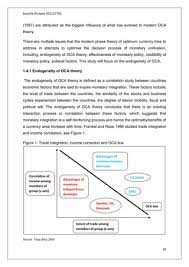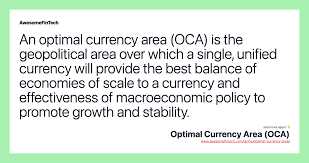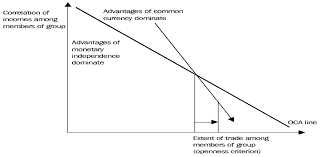What is an Optimal Currency Area?
An optimal currency area (OCA) refers to a geographic region or a group of countries that share a common currency. The concept of an OCA is based on the idea that a single currency can bring economic benefits, such as increased trade, price stability, and reduced transaction costs.
However, not all regions or countries are suitable for forming an optimal currency area. There are certain criteria that need to be met for an area to be considered optimal. These criteria include:
- Economic Integration: The countries within the area should have a high degree of economic integration, meaning they engage in significant trade and have similar economic structures.
- Openness: The area should have a high degree of openness to international trade and investment, as this promotes economic efficiency and reduces the risk of economic imbalances.
- Labour Mobility: The area should have a high degree of labour mobility, meaning workers can easily move between countries to find employment opportunities. This helps to mitigate the impact of economic shocks and reduces regional disparities.
- Fiscal Transfers: The area should have mechanisms in place for fiscal transfers, where wealthier regions provide financial support to poorer regions. This helps to address regional economic disparities and maintain stability within the currency area.
- Similar Business Cycles: The countries within the area should have similar business cycles, meaning they experience economic booms and recessions at roughly the same time. This reduces the risk of asymmetric shocks and makes it easier to implement common monetary policies.
By meeting these criteria, an optimal currency area can reap the benefits of a common currency, such as increased trade, price stability, and reduced transaction costs. However, it is important to note that forming an optimal currency area is not without challenges. It requires a high degree of coordination and cooperation among the participating countries, as well as effective governance mechanisms to address potential economic imbalances.
Definition and Criteria

In the field of economics, an Optimal Currency Area (OCA) refers to a geographic region or group of countries that share a common currency and have similar economic characteristics. The concept of an OCA is based on the idea that a group of countries can benefit from using a single currency, which can lead to increased economic integration, trade, and efficiency.
Criteria for an Optimal Currency Area
There are several criteria that are commonly used to determine whether a region or group of countries can be considered an optimal currency area:
Economic Integration

One of the key criteria for an OCA is a high degree of economic integration among the participating countries. This includes factors such as a high level of trade between the countries, a similar level of economic development, and a high degree of labor and capital mobility. A high level of economic integration helps to ensure that the benefits of using a single currency are maximized.
Similar Business Cycles

Another important criterion is the synchronization of business cycles among the participating countries. This means that the countries should experience similar patterns of economic growth, inflation, and unemployment. A high degree of synchronization helps to ensure that a single monetary policy can effectively address the economic conditions of all participating countries.
Additionally, a high degree of synchronization reduces the risk of asymmetric shocks, which occur when one country experiences a shock that affects its economy differently from the rest of the countries in the OCA. If the business cycles are not synchronized, it can lead to difficulties in implementing a single monetary policy that is suitable for all countries.
Fiscal Transfers and Risk Sharing
The ability to transfer fiscal resources and share risks is another important criterion for an OCA. In an optimal currency area, there should be mechanisms in place to transfer resources from countries that are experiencing economic downturns to countries that are performing well. This helps to mitigate the impact of asymmetric shocks and ensures that all countries in the OCA can benefit from the advantages of a single currency.
Furthermore, an OCA should have a high level of fiscal coordination and cooperation among its member countries. This includes harmonization of fiscal policies, coordination of budgetary decisions, and a commitment to fiscal discipline. A high level of fiscal coordination helps to maintain stability and prevent imbalances within the OCA.
Political and Institutional Factors
Political and institutional factors also play a role in determining whether a region or group of countries can be considered an optimal currency area. The participating countries should have a high level of political stability, a strong commitment to economic integration, and well-functioning institutions that can support the functioning of a single currency.
Additionally, there should be a high level of trust and cooperation among the participating countries, as well as a willingness to give up some degree of national sovereignty in order to benefit from the advantages of a single currency.

Emily Bibb simplifies finance through bestselling books and articles, bridging complex concepts for everyday understanding. Engaging audiences via social media, she shares insights for financial success. Active in seminars and philanthropy, Bibb aims to create a more financially informed society, driven by her passion for empowering others.
